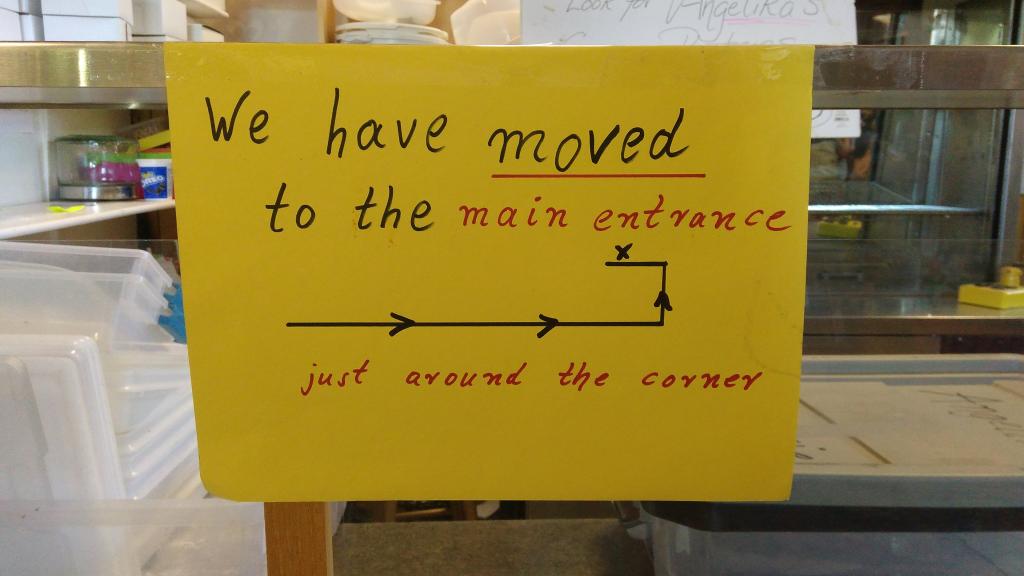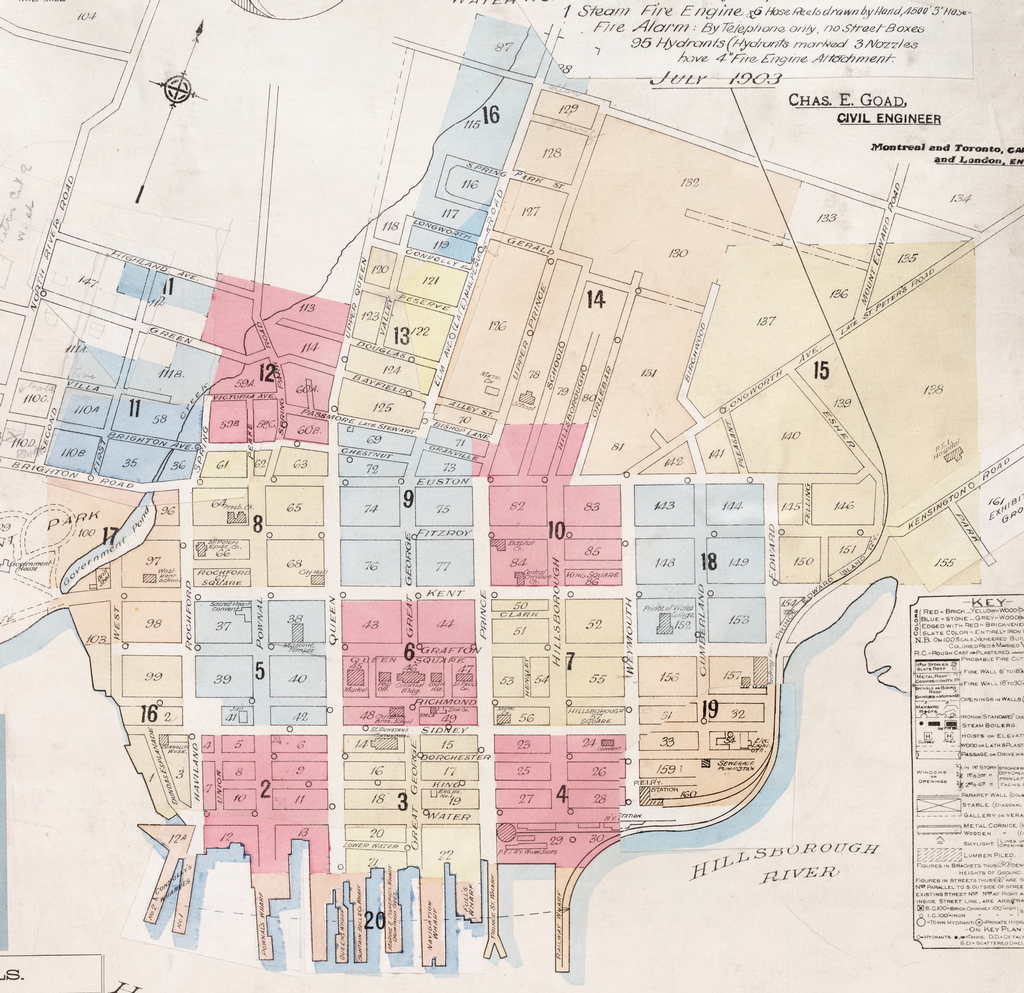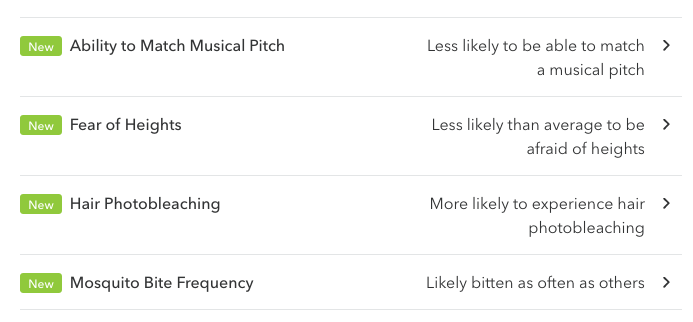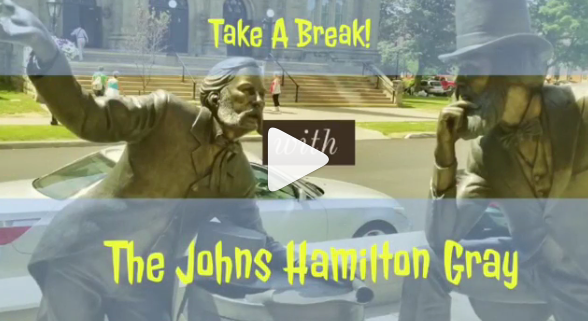Rob MacDonald’s new series, Take A Break with The Johns Hamilton Gray is my new favourite show.
For the uninitiated, John Hamilton Gray and John Hamilton Gray were both Fathers of Confederation; statues of the pair, in conversation, can be found on Great George Street opposite St. Dunstan’s Basilica in Charlottetown.
Leading up to the 100th anniversary of the end of World War I, the Clyde River blog has started posting a series of letters home from the war from former Clyde River resident Lee Grant Darrach, under the title Letters from The Great War.
They posted the first one yesterday; here’s an excerpt:
We came up the canal from Liverpool to Manchester. It is 36 miles and, Jack, I never seen such a sight in my life. Some of the finest bridges and factories and old mansions that I ever seen or I ever expect to see. It is worth a man’s life to see this place. Right handy where I am boarding, there is a home for Belgians. I seen a little girl yesterday about 12 years old with both her hands cut off at the wrists, little children maimed in every manner you could think of, it would make any man cry to see them that had a heart, children that could not harm anyone.
It’s almost inconceivable to imagine the journey of a boy from Clyde River into the maelstrom of war; Darrach is a talented, breezy writer, and to see things through his eyes provides much insight. Kudos to his Clyde River ancestors for taking this on.
This is the kind of rabbit hole that Sunday afternoons in the office are very good for.
I started to think about Ampersand, Charlottetown’s prototypical third-wave coffee place; when Ampersand closed, the space was taken over by Youngfolk & The Kettle Black, which then opened a roastery on 142 Richmond Street. When Youngfolk decided to sell, they split in two: one branch begat ROW142, which begat Receiver Coffee, the other branch begat Kettle Black. And so on and so on.
In this diagram I’ve attempted to chart the locations of venerable coffee and tea places along with the business connections (ownership or sale) between them. It’s incomplete, and likely not completely accurate. But it’s a handy reference for me to keep history at least partially straight.

Here’s a larger version of the family tree should you wish to examine it more closely.
Corrections or additions welcomed in the comments.
Lots happening at the Charlottetown Farmers’ Market these days.
With the departure of Ross Munro’s salmon bagel stand, Angelika’s German Bakery is moving into their spot by the front door. This, in turn, opens up space for Crystal Green Farms, which has been in an outbuilding in the parking lot for several years, to move inside and take Angelika’s spot. A welcome addition.
Meanwhile, back in the parking lot, the fabulous Bevan-Baker boys were serving donairs this morning using pita baked in their on-site wood-fired oven, local lamb and beef, and a fantastic garlic sauce. It was all enough to bust me temporarily out of my vegetarianism.
By the time early August rolls around, I am inured to the influx of tourists at the market, and just roll with it. This morning, with Oliver in Georgetown volunteering at Cloggeroo, I was all alone and wasn’t quite sure what to do with myself, so I dawdled, and chatted, and had both breakfast and lunch.
It’s a good time of year.

How has the synchronicity of my recent obsession with boulders and the meaning of my first name not dawned on me until now?
Petros (Greek: Πέτρος; Coptic: ⲡⲉⲧⲣⲟⲥ) is the original Greek and Coptic version of the name Peter meaning “stone” or “rock”.
(Photo by Matt Rainnie for CBC Prince Edward Island)

The Charlottetown Fire Insurance Maps are one of the most delightful elements of the Island Imagined collection of digitized images, but the interface for navigating them there doesn’t lend itself to exploration. To help make this easier, I took the index map and converted it to a static JPEG (using the technique I outlined here), and then used this free imagemap-making tool to create a set of clickable links to each map (technical note: I use Image Map Resize to ensure the image map works no matter the size of the image).
Here’s the result; just click on any of the colour-coded areas of the city to jump to the appropriate page in the Island Imagined collection, where you’ll find a slippy map that you can explore in detail.

Since writing about PEI’s newly progressive liquor regulations yesterday, I’ve had private communications with two licensed establishments that have historically used the excuse of liquor license restrictions to exclude minors at certain times of the day; I’d assumed that they would be happy to have this yoke lifted, and to welcome people of all ages into their midst.
In both cases, however, they’ve decided, liquor license restrictions or no, to maintain their policies and to deny access to minors in the evenings.
This clearly takes the issue out of the realm of government restriction and into the realm of pure discrimination on the basis of age; the justification I was given for this policy was, in essence, that they wish to maintain an “adult vibe” in the evenings (my words, not theirs).
My easiest option when faced with this discrimination is to simply withdraw my patronage of these establishments, and I’ve done that, after making it clear to both why I have done so.
But I remain uncomfortable with the notion that businesses are operating, in defiance of clearly understood humans right principles, because they’ve decided its okay.
Many years ago there was a bar in Peterborough, Ontario called the Montreal House that had a well-known policy, never explicitly stated, of not allowing women inside. One summer afternoon I found myself with a diverse group of about a dozen women who decided to confront this policy head-on, and they invited me to join them. We went into the bar, found ourselves a table, and waited to be served. No service came. We waited longer.
Eventually a couple of us went up to the bar and asked to place an order; the barkeep said “I can serve him,” pointing at me, “but I can’t serve you.”
“Why not?”, one of the women asked.
“You know why,” he replied.
We went back and sat down. A few minutes later the barkeep started to turn off the lights and announced that the bar was closing for the day and we were all asked to leave, which we did.
I suspect that as soon as we were down the street things picked up where they left off before we arrived on the scene.
That was clear, bald-faced discrimination. It was wrong.
I’m happy to report that what was once the Montreal House is now Dr. J’s BBQ & Brews and, as I’ve just confirmed on the telephone, “women are now welcome here.”
I think denying access to people on the basis of age is just as discriminatory as denying access to people on the basis of gender, and I am hopeful that, like the vast majority of businesses on Prince Edward Island, the holdouts that do not feel the same way can be convinced to see the error of their ways.
For someone like me, who’s as close to being a non-drinker as one can be (to the point where, when I answer the “lifestyle” questions from pollsters, they don’t believe my answers: “what do you mean you’ve had one drink in the last 6 months?!”), I’ve spent an inordinate amount of time railing against Prince Edward Island’s regressive liquor regulations over the years. Witness:
The Rural Levee Loop Awards 2018
The levee at the Miscouche Legion looked like a rollicking good time, with a live band and teaming revelers in attendance; alas we were turned away at the door, as it was a “19+” event, due to liquor regulations.
Xenocracies Everywhere Really Soon
Because of Prince Edward Island’s antediluvian liquor laws, Oliver was only allowed to be present until 9:00 p.m., and so there was some last minute stress surrounding whether he’d be able to go on stage before turning into a Prohibition pumpkin, but, again the Fringe team rose to the challenge and made sure he was on in the first hour.
“What If Stores Charged Admission?”
I’ve never been to Small Print because the conditions of its liquor license don’t allow Oliver, being under 19, to be there after 8:00 p.m., and if I was going to go somewhere and play board games with someone, it would be with Oliver, after 8:00 p.m.
Wherein my child’s morals are not corrupted…
Alas the visions of butter chicken and chips dancing in our heads were dashed when we were told that Churchill Arms’ liquor license wouldn’t allow minors on the premises after 8:00 p.m. They were very nice and apologetic about it, and of course it’s a matter outside of their control so we bid them no ill will.
When we showed up at the Silver Fox last night at quarter to eight, however, the man at the door took one look at Oliver and shook his head: the concert, it seems, was a “licensed event.” Meaning no kids. We could go in without Oliver, or, maybe, get our tickets refunded and all go home empty-Gallanted.
In the last 17 years that we’ve been parents, we’ve experienced all manner of heartbreak and rejection over not being able to attend events, or go to restaurants, because Oliver, who’s almost always with us, is a minor.
When Oliver was forced to leave the launch party for Island Fringe last week before 9:00 p.m., because, organizers were told, “after 9pm, Studio 1 becomes a 19+ venue,” I decided to try to get to the bottom of this: how could it be, in 2018, that we continue to have restrictions based on temperance notions that were set aside generations ago.
It turns out that we don’t have such restrictions, at least not as of this spring, when government introduced changes to liquor regulations under the Liquor Control Act that greatly liberalized age restrictions, and take the province from being sadly regressive to being uncommonly progressive in one fell swoop.
What this means, in practice, is that the days of “sorry, we don’t allow minors after 8:00 p.m.” are gone.
As I understand it, there are limited exceptions but, compared to the old regime, they are rare and apply only in special circumstances: as such, if you are told by a restaurant, venue, event or other licensee that your under 19 children cannot be admitted, they are more than likely relying on old information.
In my experience the word has been slow to get out to some licensees and event organizers on the ramifications of these changes for their particular business; it’s also possible that some businesses are using their liquor license as a conceit for age discrimination that has nothing to do with their liquor license.
In both regards its up to we in the consuming public to spread the word.
Minister of Finance Hon. Heath MacDonald and his officials at the PEI Liquor Control Commission deserve credit for taking on the challenge of thoroughly modernizing our liquor legislation for the first time since Prohibition
Matt Rainnie produced this spot for CBC Prince Edward Island’s Island Morning that aired on Friday, August 10, 2018 after the 8:00 a.m. news. He interviewed me about the Charlottetown Boulder Park, and interviewed the proprietors of the new food trucks about their role in the park’s revivification.
Many years ago I sent a sample of my DNA to 23andMe for testing and, as a result, every now and then I get emails alerting me that some new genetic trait, or some long-lost 7th cousin, has been identified as a result.
Here are the traits that were highlighted in today’s email:

So I’m a tone-deaf bleached-blond who can escape to high places to avoid the mosquitoes that will bite me at a typical rate.
In earlier communications I learned that I’m less likely to develop a bald spot, less likely to have dimples, and likely prefer salty to sweet.

 I am
I am